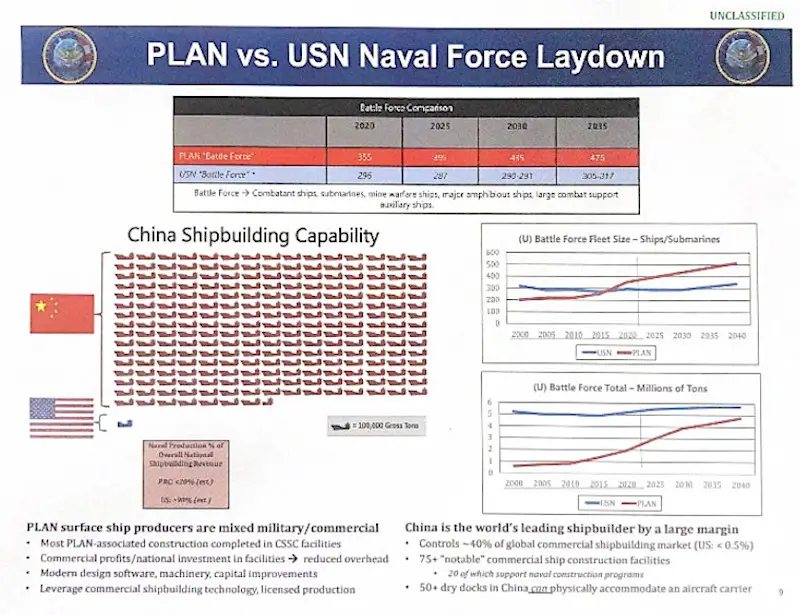
A leaked U.S. ONI slide sparks concern over China’s shipbuilding Capacity and their relentless naval vessel production, outpacing the U.S. at an alarming rate.
A leaked document from the U.S. Office of Naval Intelligence (ONI) is stirring deep concern about China’s ongoing capacity to manufacture naval vessels at an astonishing pace, leaving the United States significantly behind. In other words, China’s shipbuilding capacity far outweighs our own, and the future looks to show an even larger gap.
The leaked illustration highlights China’s shipyards, which are churning out new naval vessels at a rate 232 times greater than their American counterparts. The ONI has officially verified the authenticity of this revelation to The Drive, the first publication to break the story.
This massive capability boost for China’s People’s Liberation Army (PLA) Navy has raised red flags among analysts who fear that the United States may be unable to bridge this staggering gap for many years.
James Fanell, Retired Captain and Former Director of Intelligence for the U.S. Pacific Fleet, while acknowledging the challenges in reviving American shipbuilding, is not as pessimistic as some. He suggests that closing the gap with China will necessitate “a significant shift from the current policy of unchecked engagement under the Biden administration.”
“The challenges extend beyond political will,” Mr. Fanell emphasized, “with issues plaguing America’s shipbuilding industry dating back to the aftermath of WWII.”
Nevertheless, he remains optimistic, stating, “America’s spirit of optimism and can-do attitude will be essential in any effort to close this gap.”
According to ONI data, the Chinese regime boasted a naval fleet of 355 vessels in 2020, while the United States counted 296. Projections for 2035 indicate that China could expand to an estimated 475 ships, while the United States may reach a range between 305 and 317.
Mr. Fanell noted, “While the U.S. Navy leadership expresses concern about the growth and capabilities of the PLA Navy, it is noteworthy that not a single U.S. Navy Admiral has resigned their commission due to the perceived inadequacy in responding to this threat to our national security.”
He went on to underscore the gravity of the situation, saying, “The recent ONI disclosure serves as a stark reminder of the dramatic decline in the U.S. shipbuilding sector, which stood as a global leader just 80 years ago during World War II. America’s rise to great power status was intricately tied to its maritime prowess, and ignoring this historical fact jeopardizes our national security.”
“In 1949, more than a dozen U.S. Navy admirals were willing to put their careers on the line to voice concerns about a risky strategy relying solely on strategic bomber aircraft to combat the USSR. Their dedication to national security paid off as the U.S. Navy laid the groundwork for a formidable nuclear aircraft carrier fleet that dominated global waters for six decades, ensuring the safety and prosperity of America, our allies, and even our adversaries.”
See Related: The BRICS Threat: U.S. Dollar’s Global Supremacy Teeters on the Edge of Collapse; Dips Below 60%

The Path to Bridging the Gap
Mr. Fanell recommends that Congress pass and fund legislation resembling the Two-Ocean Navy Act of 1940, which significantly bolstered the nation’s naval presence and capabilities in both the Atlantic and Pacific Oceans.
“The parallels between today’s strategic landscape and 1940 are striking,” he emphasized.
For instance, with Russia’s invasion of Ukraine, posing a threat to Europe, and China’s ongoing large-scale naval operations near Taiwan and the Philippine Sea, Mr. Fanell stressed the need to “unleash American ingenuity to fortify our warship fleet.”
He proposed, “We should prioritize the construction of unmanned warships and equip our existing mothball fleet with supersonic/hypersonic anti-ship cruise missiles. This transformation would effectively repurpose retired vessels into formidable arsenal ships capable of countering the People’s Liberation Army Navy invasion fleet.”
During a naval conference in February, U.S. Navy Rear Adm. Michael Studeman expressed concern, remarking, “It is deeply troubling how uninformed and naive the average American is regarding China.”
Mr. Fanell, however, laid the blame at the feet of the national security community, asserting that they have failed for two decades to adequately educate the American public about the threat posed by communist China.
“The urgency of this education cannot be overstated,” Fanell insisted. “The PLA Navy’s threat extends beyond the Western Pacific and is now approaching Hawaii. If left unchecked, it will reach the U.S. West Coast within a decade. This is not a theoretical concern; it is a very real and nuclear threat.”
“While America finds itself in a precarious situation, our unwavering resolve and determination to safeguard our nation from Chinese Communism can reverse this perilous course.”
As of the time of publication, the Department of the Navy and the Office of Naval Intelligence had not responded to requests for comment.
